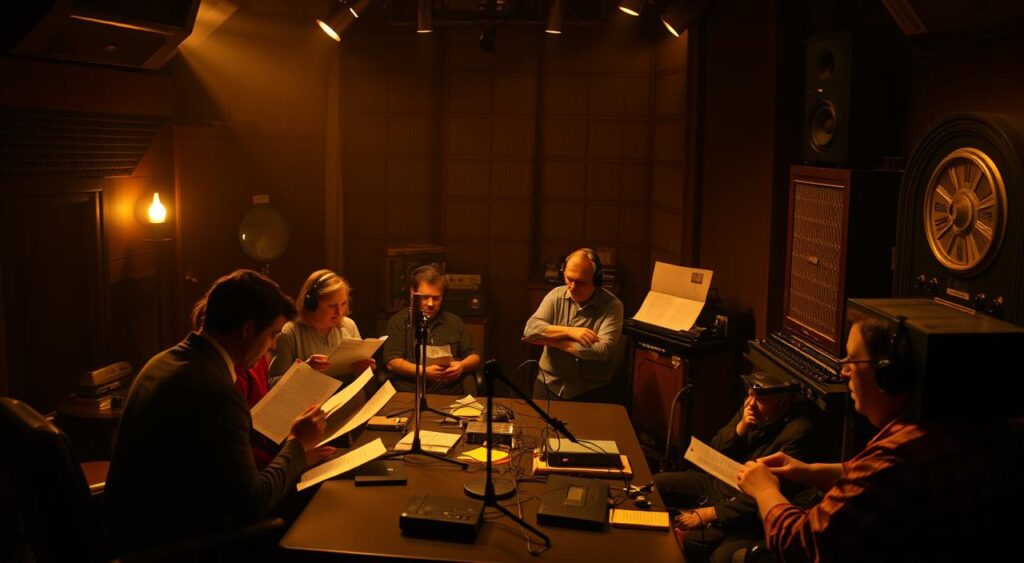Retro Radio Drama Clubs mix old-time charm with today’s tech, celebrating the original air dates of classic shows on the internet . They’re a dream spot for those who love old radio shows. Here, you can dive into the art of classic storytelling using modern gadgets. Whether you adore the Golden Age of Radio or just want a fun hobby, these clubs give you a chance to get involved or simply enjoy the shows.
Key Takeaways
- Retro Radio Drama Clubs blend nostalgia with modern technology.
- Perfect for enthusiasts of vintage radio shows and historical audio storytelling.
- Combines recording classic scripts with contemporary tech tools.
- Offers a unique platform for both participation and enjoyment.
- Ideal for creative expression and community building.
Introduction to Radio Drama
Radio drama is a sophisticated art form that has been captivating audiences for decades. This unique type of audio storytelling uses a blend of sound effects, music, and dialogue to create an immersive experience for listeners. With the rise of podcasts and audio fiction, radio drama, as a unique form of audio drama, has experienced a resurgence in popularity, making it more accessible than ever before. Whether you’re a long-time fan or new to the medium, radio drama offers a rich and engaging way to enjoy stories.
What is Radio Drama?
Radio drama is a form of audio storytelling that combines dialogue, sound effects, and music to tell a story. Typically performed by a cast of actors, radio dramas can range from comedy to drama to science fiction. These productions can be broadcast on the radio or made available as podcasts or online audio programs, including engaging radio drama scripts . What makes radio dramas unique is their ability to engage listeners’ imaginations, allowing them to visualize the story through sound alone. This interactive form of entertainment has a timeless appeal, drawing in audiences with its rich audio landscapes and compelling narratives.
What is a Retro Radio Drama Club?
Retro radio drama clubs are special places for people who love old-time audio plays. These groups honor the past by bringing classic radio storytelling into the present, often with newly created content. They combine old styles with new tech. People in these clubs get to make and act out stories from the radio’s heyday, covering the 1920s to the 1950s.
Definition and Purpose
A retro radio drama club is a group that records and performs old-time audio plays. It’s a space for creativity, letting people dive into past storytelling techniques and styles. These clubs use modern tech to bring vintage radio drama magic to life again.
The Appeal of Radio Drama
Radio drama has a special charm because it creates whole worlds with just sound. It attracts those longing for simpler times, offering rich audio experiences that allow listeners to hear and imagine entire worlds. These clubs are popular because they craft stories that pull listeners of all ages, including kids, into imaginative worlds with great voice work, music, and sound effects, often inspired by classic radio programs. These shows are presented as they were originally heard, capturing the authentic feel and enjoyment of classic audio dramas.
History and Evolution
Radio drama started in the early 20th century, with its golden age from the 1920s to the 1950s. Famous shows and actors emerged during this time. As TV became popular, radio dramas faded but never disappeared. Today’s clubs maintain this tradition, tweaking it for new platforms while keeping the classic storytelling spirit alive, including genres like science fiction .
Benefits of Joining a Retro Radio Drama Club
Joining a retro radio drama club comes with many benefits. Members often work on creating and performing various episodes of classic and modern audio dramas. It combines creative joy with practical skill-building, making it a great activity for kids. By exploring classic radio theater, you’ll find opportunities that boost both your personal and professional growth.
Creative Expression
Retro radio drama clubs are great for expressing creativity. You can try voice acting, interpreting scripts, or writing them, which lets your artistic side shine. Working with classic scripts brings old stories to life in new, imaginative, and often funny ways.
Building Community
These clubs help create a community among fans of classic radio theater. They’re places to meet, share ideas, and work on projects honoring radio drama’s legacy, even conducting phone calls to coordinate efforts. Through these clubs, members often form deep, lasting friendships, all while creating content that captivates the listener.

Skill Development
Retro radio drama clubs are perfect for learning new skills. You can get better at voice modulation, sound editing, and audio production. The practical experience you gain is great for anyone interested in media and entertainment careers, especially in creating a modern version of old classics that are professionally produced.
Fostering Teamwork
Producing classic radio theater shows requires team effort. Everyone in the club has a vital role, like acting, directing, or sound engineering, and the cast size can vary greatly depending on the production . This teamwork improves interpersonal skills, making it easier to collaborate with others.
Essential Equipment for Recording
To bring back the magic of old radio shows, you need the right gear. Quality tools and software, including those for creating original music, can significantly improve your work.
Microphones and Audio Interfaces
Great audio starts with a top-notch microphone. You might pick the Shure SM7B or the Audio-Technica AT2020 for their clear sound. An audio interface like the Focusrite Scarlett 2i2 is also key. It makes sure your sound is perfectly captured and recorded on your computer, often competing with the quality found in television.
Software for Editing
Good editing software is a must for polishing classic scripts. With Adobe Audition or Audacity, you get many tools for editing audio. They help make your vintage radio show recreations sound just right, aligning closely with the standards of audio fiction .
Sound Effects and Music Libraries
To get the real feel of old-time radio, diverse sound and music libraries are vital. Sites like SoundSnap or AudioJungle have lots of old-style sounds. They help you mimic the background noise and music of classic radio dramas, including themes surrounding war .
Selecting Classic Scripts for Production
Choosing the right radio drama scripts for your retro radio drama is key. Include popular Golden Age scripts, variety shows undiscovered works, and modern ones adapted for the retro look. This mix keeps contemporary audiences hooked and grows the club’s collection.

Popular Choice: Golden Age Scripts
Golden Age Radio scripts are loved by many. They’re from famous writers like Norman Corwin and Arch Oboler, who created iconic shows called “The Shadow” and “Lights Out.” These scripts bring back classic radio theater’s magic.
Notable Examples of Classic Radio Dramas
Some notable examples of classic radio dramas include “The Shadow,” “The War of the Worlds,” and “Suspense.” Another iconic character from this era is Johnny Dollar, known for his involvement in various investigations linked to insurance and crime. These shows were performed live and featured a talented cast of actors, intricate sound effects, and original music. Philip Marlowe, a character synonymous with solving mysteries and uncovering hidden truths, also played a significant role in the popularity of detective narratives. They were incredibly popular during their time and helped establish radio drama as a major form of entertainment. Modern radio dramas, such as “Welcome to Night Vale” and “The Magnus Archives,” have continued this tradition, introducing the magic of radio drama to a new generation of listeners. These contemporary shows blend the classic elements of radio drama with modern storytelling techniques, ensuring that the art form remains vibrant and relevant.
Lesser-Known Gems
Looking at lesser-known works rewards your club. They offer unique stories usually missed in old radio shows. Finding these stories brings new and interesting plays to your audience.
Adapting Modern Works to Retro Styles
Making modern scripts fit the old-style radio theater is fun. It combines creative ideas with the classic radio vibe. This move draws more people and shows radio drama’s enduring appeal.
Writing for Radio Drama
Writing for radio drama requires writing requires a unique set of skills, as it is a highly visual medium that relies on sound to create the story. Writers must be adept at crafting engaging scripts that use dialogue, sound effects, and music to bring the story to life. This involves a deep understanding of how to use audio elements to set the scene, develop characters, and advance the plot.
Crafting Engaging Scripts
To craft engaging scripts for radio drama, writers must consider how the scripts are written for the audio medium and how to use sound to create the story. This includes using sound effects to set the scene, creating distinct voice patterns for each character, and using music to enhance the mood and atmosphere. Writers must also be mindful of the cast size and how to use dialogue to advance the plot and reveal character. By considering these factors, writers can create engaging and immersive scripts that will captivate listeners and transport them to new worlds where you can hear and experience them. Whether you’re writing a comedy, drama, or science fiction story, the key to success is to use the audio medium to its fullest potential and to create a story that will engage and entertain your audience.
The Recording Process Explained
The journey of recording traditional audio plays starts with detailed prep work. It ends with finished, polished productions. This section highlights each key step. It ensures your recordings of classic scripts capture the essence of vintage radio drama as a sophisticated art form .
Script Read-Throughs
Script read-throughs are the first step in preparing for each episode. These sessions help the cast get to know the material. Actors understand their parts and come together on the text’s meaning. Such read-throughs create unity among the actors. They make sure everyone is ready for a captivating show.
Voice Acting Techniques
Mastering voice acting techniques is key for great old-fashioned audio plays. Actors work on getting emotions and accents just right. They use vocal exercises and practice speaking clearly. This makes their performance strong and touches the audience deeply.
Editing and Post-production
The last stage is all about careful editing and post-production. It’s crucial for the audio plays to sound authentic and high-quality. Editors remove noise, match dialogue, and add effects or music, ensuring the quality rivals that of television . The end product is smooth and brings listeners into the world of classic radio drama.
Hosting Live Performances
Bringing stories to life on stage makes the old tales feel new again. It creates an atmosphere that matches the story’s time. This way, the audience gets pulled into the magic of old radio shows, making it memorable.
Creating a Unique Atmosphere
Attention to detail is key to take your audience back in time, making them feel like they are at an old radio station. Decorate the venue with vintage items and costumes that fit the story’s era. Use lighting and sound, and even incorporate telephone calls, to make the setting even more real.
Engaging with the Audience
Connecting with the audience is important for a show they’ll remember. Use live sound effects and let the audience join in. This adds a real feeling to the show. Listening to what the audience thinks makes the experience better for everyone. Encourage your audience to listen to the broadcasts to fully immerse themselves in the rich narratives and historical contexts.
Recording for Broadcast
Recording your live shows lets more people enjoy them. Good recording gear catches every detail of the performance. Sharing these recordings online via the internet brings traditional storytelling to new listeners. This helps keep the magic of old-time radio alive.

Classic stories like those of Sherlock Holmes are revitalized through modern recordings.
The Podcast Revolution
The podcast revolution has transformed the landscape of modern radio drama, offering new opportunities for creators to produce and distribute high-quality audio dramas. With the rise of podcasting, radio drama has experienced a resurgence in popularity, with many modern radio dramas being produced and released as podcasts. This shift has allowed for a more diverse range of voices and styles to emerge, enabling creators to push the boundaries of the medium. Podcasts provide a platform for innovative storytelling, reaching audiences worldwide and making radio drama more accessible than ever before. Whether you’re a fan of classic tales or new narratives, the podcast revolution ensures there’s something for everyone in the world of audio drama.
The Art of Telling Stories with Sound
The art of telling stories with sound is a cornerstone of radio drama, requiring a deep understanding of the medium and its unique capabilities. Radio drama scripts must be meticulously crafted to convey the story and characters through sound alone. Techniques such as sound effects, music, and dialogue are essential in creating a rich and immersive audio environment. By skillfully using these elements, creators can transport listeners to new and imaginative worlds, fostering a sense of intimacy and connection with the story and characters. This auditory magic allows listeners to visualize scenes and emotions, making radio drama a powerful and engaging form of storytelling.
Techniques in Audio Storytelling
Audio storytelling employs several techniques to create a captivating experience. Sound effects and music are used to set the scene and enhance the mood, while dialogue drives the narrative forward. Editing and mixing play crucial roles in building tension and guiding the listener’s attention. Creators often experiment with the medium’s unique capabilities, incorporating elements of horror, science fiction, or comedy to craft innovative and experimental audio dramas. These techniques not only enrich the story but also ensure that listeners are fully immersed in the audio experience, making each drama a memorable journey.
A Wide Range of Genres
Radio drama encompasses a wide range of genres, from comedy and drama to science fiction and horror. Each genre offers its own unique challenges and opportunities, requiring a deep understanding of the medium and its capabilities. By exploring the diversity of radio drama, creators can discover new and innovative ways to tell stories and engage with audiences. Whether it’s the suspense of a thriller, the humor of a comedy, or the wonder of a science fiction tale, radio drama’s versatility allows for endless creative possibilities. This diversity ensures that there is always something new and exciting for listeners to enjoy.
Exploring Diversity in Radio Drama
Exploring the diversity of radio drama can be a rewarding and enriching experience, offering a wide range of styles, genres, and themes to discover. From the classic radio dramas of the golden age to modern podcasts and audio fiction, there is a wealth of material to explore and enjoy. By listening to and engaging with a wide range of radio dramas, audiences can develop a deeper appreciation for the medium and its unique capabilities. This exploration can reveal new and innovative ways to tell stories and engage with the world around them. Whether you’re interested in comedy, drama, science fiction, or horror, there’s a radio drama out there for you, and the possibilities are endless.
Marketing Your Radio Drama Club
Marketing well will make your retro radio drama club more visible. You’ll draw in fans who love old-time radio. Use social media, create a great website, and work with local media, leveraging the internet to succeed.
Utilizing Social Media
Platforms like Facebook, Instagram, and Twitter are great for finding fans. Post cool behind-the-scenes shots, classic theater clips, and highlight members. Also, share news about shows and new projects to keep fans up to date.
Building a Website
Your website should grab the attention of new people and fans. It needs info on the club’s history, event details, and joining instructions. Add audio clips of performances and blogs about retro drama to keep visitors coming back.
Collaborating with Local Media
Working with local news can really get the word out, especially if you have an event or show happening that week. Send press releases about your shows and offer event invites. Coverage could include articles and interviews. This brings in fans and newcomers alike.
Resources for Retro Radio Drama Enthusiasts
Being part of retro radio drama clubs is more than just listening and joining in. There are many resources out there for those who love these dramas and want to learn more. You can find online communities, insightful books, articles, and even courses to improve your skills.
Online Communities and Forums
Online communities and forums are great for fans of retro radio drama from any country. In these spaces, people share tips, talk about equipment, and suggest scripts to each other. Sites like Old Time Radio Researchers and Reddit’s Old Time Radio community are filled with helpful advice and lively discussions.
Books and Articles on Radio Drama
If you’re keen to learn more about the art and history of retro radio, there are lots of books and articles. Works like “An Introduction to Old-Time Radio” by Ron Lackmann and “The Great American Broadcast” by Leonard Maltin are packed with insights. You can also find deep thoughts in academic journals like Journal of Radio & Audio Media.
Workshops and Courses
Workshops and courses give you hands-on experience in making retro radio dramas. Schools like New York University and the University of Maryland have programs on voice acting, scriptwriting, and sound editing. Plus, many of these programs are online, so you can join from anywhere.
Case Studies of Successful Clubs
Exploring retro radio drama clubs shows us a lot about audio storytelling. Successful clubs share their smart practices, inventive ways of production, and important lessons learned. This knowledge can help you follow in their footsteps.
Spotlight on Established Clubs
“L.A. Theatre Works” in Los Angeles is a standout club known for its high-quality shows, often focusing on a particular show to draw in fans. It features famous actors, and this approach has earned them many fans and kept their production standards up.
The “Sonic Society” club has reached fans worldwide by using podcasts. They adapt old scripts for today while keeping the retro charm alive. Their smart use of tech has introduced vintage audio dramas to new listeners.
Innovative Approaches to Radio Drama
Innovation is key for these clubs. For example, some use social media to get live feedback during script readings. This adds an interactive twist for the audience, bringing elements of modern radio drama into the mix .
They also mix modern editing tools with classic sound effects. This mix appeals to those who love both quality and nostalgia in their audio experiences.
Lessons Learned from Experience
These clubs stress the value of connecting with the community. Holding live events and workshops at the community station brings members and listeners closer.
It’s essential to balance creativity with practical matters. “The National Audio Theatre Festivals” is adept at this, planning well to keep quality high without stifling creativity.
| Club Name | Innovative Approach | Lessons Learned |
| L.A. Theatre Works | Involvement of professional actors | Maintain high production standards |
| Sonic Society | Leveraging podcast formats | Engage a global audience |
| National Audio Theatre Festivals | Interactive workshops | Balance creativity with logistics |
Overcoming Challenges in Production
Creating a memorable radio drama means facing many challenges. These range from technical issues to managing a diverse team. But each problem lets us learn and grow.
Navigating Technical Difficulties
Technical issues, like bad microphones or software crashes, often occur in radio production. Being ready with extra equipment and a plan B is key. It’s also important to regularly check and fix your gear for a smooth process.

Managing Member Dynamics
For old-time radio plays to work, teams must collaborate well, bringing together diverse voices. Good communication and clear rules help keep everyone happy. It’s vital to meet often, talk about any problems, and celebrate wins together.
Budgeting for Projects
Money problems can make it tough, but smart budgeting helps keep productions high-quality. It’s crucial to spend wisely on necessary gear and find cheap options like free sound effects or volunteer actors. Additionally, fundraising or finding sponsors can give extra money for your projects.
Future of Retro Radio Drama Clubs
Retro radio drama clubs are gaining popularity, thanks to new tech. Modern tools can make old stories sound even better. This means they can keep the charm of old-time radio while meeting today’s audio standards.
Incorporating Technology Advances
Nowadays, high-tech tools are key for retro radio fans. Things like high-quality mics and advanced editing software are becoming must-haves. They help make the dramas sound clearer and more realistic.
Expanding Diverse Storytelling
Retro radio drama clubs are also embracing diverse stories. By sharing stories from different cultures, including themes of war they attract a wider audience. This makes old stories feel new and lets them create plays that mirror today’s world in a modern way.
Trends to Watch in Audio Entertainment
It’s important for clubs to stay updated with audio trends. Podcasts and serialized storytelling are getting more popular. Also, using VR could make listening even more immersive. Keeping up with these trends will help clubs stay relevant and exciting.
FAQ
What is a Retro Radio Drama Club?
A Retro Radio Drama Club brings old-time radio plays back using modern tech. It’s a place for people who love classic storytelling to be creative and remember the past. These groups love the drama from radio’s golden era.
What is the appeal of radio drama?
Radio drama pulls you in with stories and sounds. It lights up your imagination, makes you feel nostalgic, and takes you to other worlds. All this is done with great voice acting and sound effects.
How has radio drama evolved over the years?
From the 1920s to the 1950s, radio drama was huge. Now, it has gotten even better with tech. The sound quality has improved. This keeps it popular among fans of vintage shows and those who love old-time theater.
What are the benefits of joining a Retro Radio Drama Club?
Being part of one of these clubs is great for many reasons. You get to express yourself, meet people who share your interests, and learn about sound production. You’ll also work as a team on projects.
What equipment is essential for recording old-fashioned audio plays?
You’ll need good mics, reliable audio interfaces, advanced editing software, and lots of sound effects. These recreate the authentic vibes of past times.
How do clubs select classic scripts for production?
Clubs pick from famous Golden Age scripts but also hunt for unknown gems. They sometimes tweak modern stories to fit the retro vibe. This keeps their work interesting and fresh.
What is the typical recording process in a retro radio drama club?
The process starts with reading the script together. Then, actors practice their lines and accents. Finally, there’s lots of editing to make everything sound just right.
How can clubs create an engaging atmosphere for live performances?
To make live shows pop, clubs set up a scene that fits the story’s era. They include the audience to make it interactive. Recording or streaming these events lets even more people enjoy them.
What are some effective marketing strategies for a retro radio drama club?
Good marketing moves include using social media and creating an interesting website. Teaming up with local media and community program helps too. These strategies draw in more people to shows and to join the club.
What resources are available for retro radio drama enthusiasts?
There are online communities and forums for sharing tips. You can also find books and articles about radio drama’s history and how to create it. Plus, there are training workshops and courses.
How can examining case studies of successful clubs be beneficial?
Looking into how successful clubs do things can teach you a lot. You’ll learn about what works well and how to keep your audience hooked. It helps to see how they’ve overcome challenges too.
What challenges do radio drama clubs face and how can they overcome them?
Clubs often deal with tech problems, team issues, and budget limits. Solving these problems requires good planning, clear talking, and thinking outside the box.
What does the future hold for retro radio drama clubs?
The outlook is bright as these clubs embrace newer tech and tell a wider range of stories, avoiding too much information overload . Staying in tune with audio trends will keep them exciting for newcomers.






